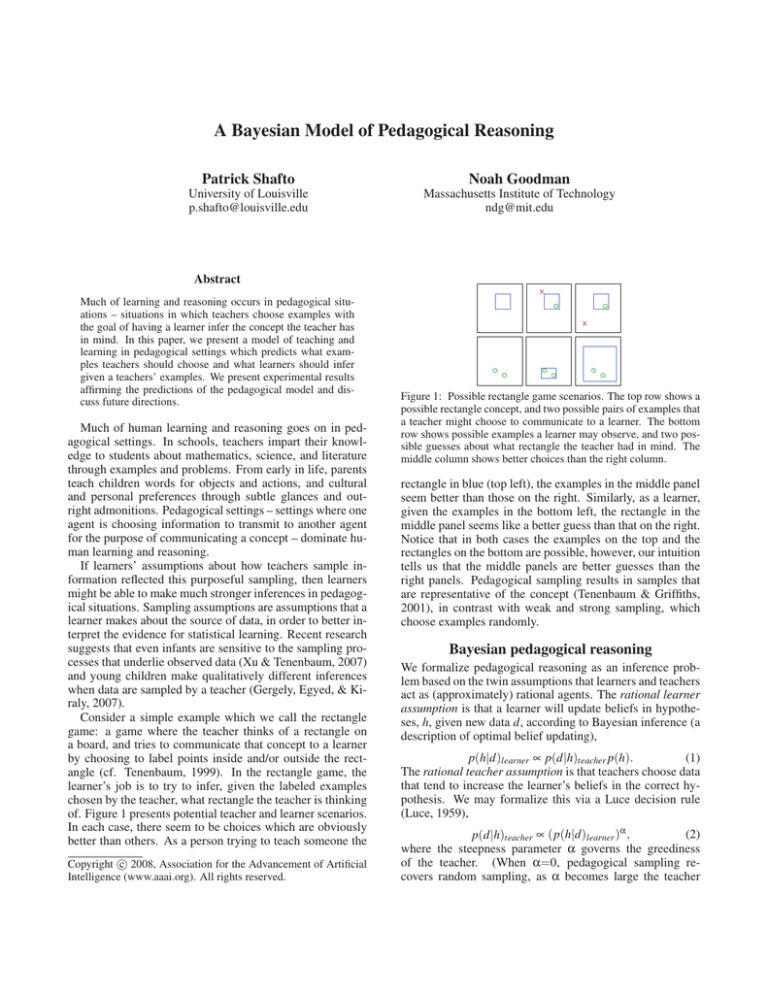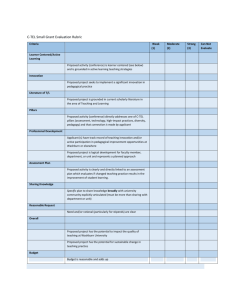
A Bayesian Model of Pedagogical Reasoning
Patrick Shafto
Noah Goodman
University of Louisville
p.shafto@louisville.edu
Massachusetts Institute of Technology
ndg@mit.edu
Abstract
X
Much of learning and reasoning occurs in pedagogical situations – situations in which teachers choose examples with
the goal of having a learner infer the concept the teacher has
in mind. In this paper, we present a model of teaching and
learning in pedagogical settings which predicts what examples teachers should choose and what learners should infer
given a teachers’ examples. We present experimental results
affirming the predictions of the pedagogical model and discuss future directions.
Much of human learning and reasoning goes on in pedagogical settings. In schools, teachers impart their knowledge to students about mathematics, science, and literature
through examples and problems. From early in life, parents
teach children words for objects and actions, and cultural
and personal preferences through subtle glances and outright admonitions. Pedagogical settings – settings where one
agent is choosing information to transmit to another agent
for the purpose of communicating a concept – dominate human learning and reasoning.
If learners’ assumptions about how teachers sample information reflected this purposeful sampling, then learners
might be able to make much stronger inferences in pedagogical situations. Sampling assumptions are assumptions that a
learner makes about the source of data, in order to better interpret the evidence for statistical learning. Recent research
suggests that even infants are sensitive to the sampling processes that underlie observed data (Xu & Tenenbaum, 2007)
and young children make qualitatively different inferences
when data are sampled by a teacher (Gergely, Egyed, & Kiraly, 2007).
Consider a simple example which we call the rectangle
game: a game where the teacher thinks of a rectangle on
a board, and tries to communicate that concept to a learner
by choosing to label points inside and/or outside the rectangle (cf. Tenenbaum, 1999). In the rectangle game, the
learner’s job is to try to infer, given the labeled examples
chosen by the teacher, what rectangle the teacher is thinking
of. Figure 1 presents potential teacher and learner scenarios.
In each case, there seem to be choices which are obviously
better than others. As a person trying to teach someone the
c 2008, Association for the Advancement of Artificial
Copyright Intelligence (www.aaai.org). All rights reserved.
O
O
X
O
O
O
O
O
O
Figure 1: Possible rectangle game scenarios. The top row shows a
possible rectangle concept, and two possible pairs of examples that
a teacher might choose to communicate to a learner. The bottom
row shows possible examples a learner may observe, and two possible guesses about what rectangle the teacher had in mind. The
middle column shows better choices than the right column.
rectangle in blue (top left), the examples in the middle panel
seem better than those on the right. Similarly, as a learner,
given the examples in the bottom left, the rectangle in the
middle panel seems like a better guess than that on the right.
Notice that in both cases the examples on the top and the
rectangles on the bottom are possible, however, our intuition
tells us that the middle panels are better guesses than the
right panels. Pedagogical sampling results in samples that
are representative of the concept (Tenenbaum & Griffiths,
2001), in contrast with weak and strong sampling, which
choose examples randomly.
Bayesian pedagogical reasoning
We formalize pedagogical reasoning as an inference problem based on the twin assumptions that learners and teachers
act as (approximately) rational agents. The rational learner
assumption is that a learner will update beliefs in hypotheses, h, given new data d, according to Bayesian inference (a
description of optimal belief updating),
(1)
p(h|d)learner ∝ p(d|h)teacher p(h).
The rational teacher assumption is that teachers choose data
that tend to increase the learner’s beliefs in the correct hypothesis. We may formalize this via a Luce decision rule
(Luce, 1959),
(2)
p(d|h)teacher ∝ (p(h|d)learner )α ,
where the steepness parameter α governs the greediness
of the teacher. (When α=0, pedagogical sampling recovers random sampling, as α becomes large the teacher
Discussion
(a) Positive examples
(b) Negative examples
Figure 2: Distributions of examples in the teaching task for (a) positive examples and (b) negative examples. Dark coloring indicates
areas that are more likely. Negative examples have been collapsed
into one quadrant of the board. Pictured from left to right in each
panel are the predictions of random (strong and weak) sampling,
the observed human data, and the predictions of pedagogical sampling. For the models, figures display the probability of an example
in each block. For human data, the proportion of positive examples
in each location is plotted. People strongly preferred to give positive examples in the corners of the rectangle and negative examples
near the boundaries, as predicted by pedagogical sampling.
Figure 3: Results from the learning task. Plots show the positions of the teacher’s examples, relative to the rectangles drawn
by learners for positive (left) and negative (right) examples. The
results show that learners clearly understand that teachers are sampling data pedagogically – positive examples indicate corners of the
correct rectangle, and negative examples indicate the boundaries.
chooses the best examples.) Because Equations 1 and 2 are
linked (with the optimal teaching behavior depending on the
learner, and vice versa), rational pedagogical reasoning is a
solution to this system of equations.
To understand this model it helps to consider one way
of solving the system of equations: fixed-point iteration.
Imagine that you are the learner, and wish to update your
beliefs. To do so you will need an estimate of the likelihood p(d|h)teacher of seeing the examples you are given.
You can estimate this likelihood by assuming the teacher is
rational—Eq. 2—but to do this you need an estimate of the
p(h|d)learner used by the teacher. If you assume the teacher
assumes that you are rational, you can use Equation 1 as
such an estimate.... This recursive reasoning could carry on
forever, but eventually the estimated values from repeatedly
using equations 1 and 2 will converge—we then say that the
process has iterated to a fixed point, and this fixed point will
necessarily be a solution to the system of equations defining
rational pedagogical reasoning. Thus we can understand the
model as capturing the outcome of a recursive mental reasoning process, based on twin rational agent assumptions.
However, it is worth emphasizing that rational pedagogical
reasoning describes the outcome of this process (or rather
the solution to the system of equations), and it is entirely
possible that this reasoning may be implemented by a psychological process that doesn’t require any explicit recursive
reasoning.
Figures 2 and 3 show the results of experiments (n =
18)conducted using the game described in the introduction.
The results show that people’s behavior closely matches
model predictions.
Much of human learning occurs in pedagogical situations –
social situations where one person chooses information for
the purpose of helping another learn. We have presented
a formal model of pedagogical reasoning, addressing which
examples teachers should choose to communicate ideas, and
what inferences learners should make based on this purposefully sampled data. We also presented two experiments testing the predictions of this model in a simple experimental
setting.
Though modeling pedagogical reasoning in richer domains is a significant challenge, it highlights a great strength
of our model. We have formalized pedagogical reasoning in
the abstract language of probability and Bayesian reasoning, without reference to the specific details of the particular
setting we considered here. As a result we are able to derive predictions in principle for any domain for which we
can identify an appropriate set of hypotheses. Interesting
domains to pursue include word learning, where speakers
choose words to communicate ideas, and causal learning,
where a helpful teacher may significantly reduce the number of interventions required to learn latent causal structure.
One of the things that make people special is that we can
teach others what we know (Csibra, 2007). However, even
when we are teaching others, we never communicate the
complete idea in precise detail. As a result, people must resolve a difficult inference problem in order to capitalize on
the information teachers provide. Gergely et al. (2007) have
shown that children do capitalize on these situations, and
they argue that pedagogical reasoning is among the powerful tools children have for learning about the world. Much
work remains before the breadth of the implications of pedagogy for human learning are understood, but our work, providing a computational basis for understanding these kinds
of inferences, represents a step in this direction.
Acknowledgments: This is a shortened version of a paper that
appeared in the 2008 Proceedings of the Cognitive Science Society.
References
Csibra, G. (2007). Teachers in the wild. Trends in Cognitive
Sciences, 11, 95–96.
Gergely, G., Egyed, K., & Kiraly, I. (2007). On pedagogy.
Developmental Science, 10, 139–146.
Luce, R. D. (1959). Individual choice behavior. New York:
John Wiley.
Tenenbaum, J. B. (1999). Bayesian modeling of human
concept learning. In M. Kear, S. A. Soller, T. K. Leen,
& K. R. Müller (Eds.), Advances in neural processing
systems 11 (pp. 59–65). MIT Press.
Tenenbaum, J. B., & Griffiths, T. L. (2001). The rational basis of representativeness. In Proceedings of the
23nd annual conference of the Cognitive Science Society (pp. 1036–1041). Hillsdale, NJ: Erlbaum.
Xu, F., & Tenenbaum, J. (2007). Sensitivity to sampling in
Bayesian word learning. Developmental Science, 10,
288–297.





